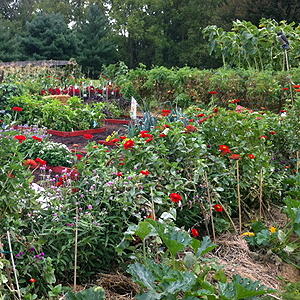
High-Yield Gardening Strategy
This is a Sponsored post written by me on behalf of Whitney Farms. All opinions are 100% mine.
Have you started your garden this year? I wish I could say the beautiful garden pictured above was in my backyard, but there’s no way. My poor garden is currently bare – things are crazy right now because we’re getting ready to move, so planting hasn’t been on the priority list.
BUT, I would love to have a high-yield garden like the one above. This picture is from Organic Gardening. They’re serious when they say high-yield too – they harvested nearly 1/2 a ton of produce from a 15×20 plot.
Keys to growing a high yield garden
Keys to growing a high yield garden, according to Organic Gardening, include building up your soil. You can do this by building raised beds, to give the roots plenty of room to grow. Carefully mixing your organic soil, and including organic plant food is important so your plants will have all of the nutrients they need to grow. If your plants have good nutrients, that means they will provide good nutrients for our bodies too! (Too many of our foods are grown in poor, worn out soil these days, so their nutritional quality is lacking.) I would choose only organic plant food, like from Whitney Farms®, that will help make up for any deficiencies in the soil.
Make sure to use soil and plant food with organic ingredients to keep our food free from chemicals! Conventional plant foods can carry all sorts of chemicals, while organic plant food has easily accessible, chemical-free nutrients.
Your local Ag Extension can also help you plan for the ideal soil for your area.
Maximize your space by paying attention to how your seeds are planted. If you plant in a triangle, you can get approx 10 to 14% more plants in each bed!
Planting vertically will also greatly help increase your yield. I grew green beans along our fence, and they took up much less space than if they’d just spread out throughout the bed.
Planting different plant combinations also saves space.
Consider the classic Native American combination, the “three sisters”—corn, beans, and squash. Sturdy cornstalks support the pole beans, while squash grows freely on the ground below, shading out competing weeds. This combination works because the crops are compatible. – Organic Gardening
Succession planting is a very strategic way to produce more crops in a small space. For example, plant a winter lettuce, then your first crop of corn. Then you can plant more greens or another plant, all in the same space! I like to plant the first round of a crop I really like, wait a couple of weeks, and then plant again. That yields a longer harvesting season!

If you’d like to try Whitney Farms organic plant food, they’re offering Renaissance Mama readers a $3 printable coupon!

This is a sponsored post on behalf of Whitney Farms. All opinions are mine.
Join us at Frugally Sustainable!


2 Comments
Paul
For large plants, how about digging a hole, filling with compost and planting in that?
Pingback: